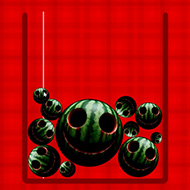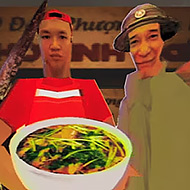Do Not Grow This Watermelon introduces players to a puzzle experience that grows more complex with every move. At the start, the screen is nearly empty, and only a few small fruits fall into the container. These early rounds feel safe and manageable. Yet the danger builds quickly. Each time two identical fruits connect, they merge into a larger fruit, and the sequence repeats. The challenge lies in the fact that as fruits grow bigger, the board shrinks in terms of usable space. The ultimate threat is the watermelon, which not only occupies a massive portion of the field but also brings you dangerously close to losing the round. Every player who enters this puzzle soon realizes that survival depends on careful strategy, not quick reflexes alone.
Core mechanics that shape every round
Although the rules are simple, the way they interact creates depth. Do Not Grow This Watermelon forces players to think beyond their immediate moves. The merging ladder ensures that every piece dropped has long-term consequences. A single misplaced apple can block the merging of cherries, creating chaos that only grows worse as more fruits appear. This means that winning strategies rely on patience, foresight, and precision.
- Anticipation is crucial — planning for the next fruit can prevent bottlenecks.
- Space management is key — large fruits demand specific placements to avoid clutter.
- Chain merges save runs — creating multiple combinations in one move frees space quickly.
- Delaying the watermelon is the goal — it always appears eventually, but every turn delayed is an achievement.
Strategic methods to extend your score
Some players treat the game as a casual diversion, while others approach it like a tactical puzzle. Those aiming for higher scores often adopt habits that extend survival:
- Start from the bottom — clearing low rows prevents tall, unstable stacks.
- Use edges intelligently — walls can stabilize awkward fruits and hold mismatches until needed.
- Leave the center open — empty space in the middle allows for chain reactions.
- Prepare for merges — don’t drop blindly; imagine how two or three moves will connect.
- Recover early mistakes — small errors at the start can often be fixed if you act quickly, but late errors are fatal.
Why the gameplay loop is so engaging
Every round is different, thanks to the unpredictable order of falling fruits. Sometimes you’ll have a sequence that merges smoothly, giving you room to grow your score. Other times, an unlucky streak forces you to adapt with quick thinking. This variety keeps players returning again and again. The mixture of predictability (knowing the fruit ladder) and randomness (not knowing the drop order) creates a tension that never fades.
Do Not Grow This Watermelon stands out because it doesn’t require long tutorials or complicated instructions. The challenge is instantly clear but endlessly replayable. Each run becomes a personal test of how long you can last before the inevitable watermelon arrives. For those who enjoy strategy under pressure, it remains a rewarding puzzle that constantly pushes your skills further.














 Fullscreen
Fullscreen


